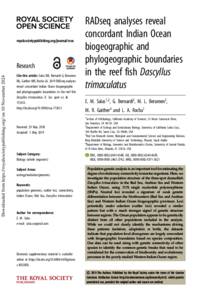Document
RADseq analyses reveal concordant Indian Ocean biogeographic and phylogeographic boundaries in the reef fish dascyllus trimaculatus.
Identifier
DOI: 10.1098/rsos.172413
Source
Royal Society Open Science. v. 6, 5, 172413
Contributors
Country
United Kingdom.
Publisher
Royal Society Publishing.
Gregorian
2019-05-01
Language
English
English abstract
Population genetic analysis is an important tool for estimating the degree of evolutionary connectivity in marine organisms. Here, we investigate the population structure of the three-spot damselfish Dascyllus trimaculatus in the Red Sea, Arabian Sea and Western Indian Ocean, using 1174 single nucleotide polymorphisms (SNPs). Neutral loci revealed a signature of weak genetic differentiation between the Northwestern (Red Sea and Arabian Sea) and Western Indian Ocean biogeographic provinces. Loci potentially under selection (outlier loci) revealed a similar pattern but with a much stronger signal of genetic structure between regions. The Oman population appears to be genetically distinct from all other populations included in the analysis. While we could not clearly identify the mechanisms driving these patterns (isolation, adaptation or both), the datasets indicate that population-level divergences are largely concordant with biogeographic boundaries based on species composition. Our data can be used along with genetic connectivity of other species to identify the common genetic breaks that need to be considered for the conservation of biodiversity and evolutionary processes in the poorly studied Western Indian Ocean region.
ISSN
2054-5703
Category
Journal articles

